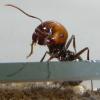As someone who is prone to halluzinations (I got them from fever from a very early age and I even once halluzinated from a very hot Thai curry, my brain is just wired weirdly) I actually think that could work.
However, I never got halluzinations from insect stings, and I have been stung by local fire ants, burning hair caterpillars, wasps, hornets, bees and so on (I was a very inquisitive kid and insects always fascinated me). But of course even as a kid I never tried to eat them.
I also did read Schmidt's book (The Sting of the Wild) and found that fascinating.
The most fascinating point about the Harvester ants is- why do the American harvester ants, which are Myrmecines like their old world counterparts, still have their sting and have a potent poison, while my own European harvester ants (Messor barbarus) have lost their sting? Schmidt suspects in his book, that potent insects poisons, that are painful to predators, evolved because these insects have something to lose, like a large grain store (of honey in bees) which they have to protect at all costs to survive.
So why is it that Messor spp. have lost their ability to sting, even when they can have several kilograms of grain in their nests (and people have been raiding these nests in famines and these ants are even described in the bible as fruitful harvesters)?
For me, this does not make sense. Pogonomyrmex form colonies of about the same size as Messor, and I assume they collect a similar amount of seed.
However, I have NO experience with new world harvester ants, since I am from Europe, so I can neither say anything about their grain collections nor anything about their sting.
As for your fear that your ants would escape and swarm you or your family.
I have kept ants in my youth, in my small bedroom.
My family was also not impressed, but at least my granddad supported me (I even was able to keep a small colony of protected Formica ants with the help of my granddad who was friends with the local forester).
I had all kinds of ants and other insects escape into my room.
Even when some of my European harvesters escape now, I never ever have been swarmed by them before.
I think it does not happen with any ant species we keep as pets.
They just do not see us as prey, and even my most aggressive ants (European fire ants which I had as a kid) gave up on the attack after a while when I retreated. They lose interest after a while, since it is just not in the interest of their colonies to chase down any predators. They protect their nest, and make the predator leave.
They do not plan an escape and then try to murder you in your sleep in an elaborate revenge plot.
This will not happen.
Even in the tropics, the army ants, do not really swarm humans.
There is a VERY excellent book on army ants, with awesome pictures (Army Ants- Nature's Ultimate Social Hunters) which I highly recommend, as well as Mark Moffets "Adventures among ants" where he described being swarmed by marauder ants and army ants- reason, he was observing them, got too close to the column and then was sitting there unmoving for a while. He just retreated a few meters and all was fine again.
The reports of humans living with army ants, they actually welcome the swarm visiting their houses, since the ants move through, clean up the vermin, and then move on. The humans just go into a different room while the ants do their job in another room of the house. There is this report from one person (it is from one of the above books, but I do not remember, which) who was sleeping and the family had not told him that they expected their ant visitors that day, so the person woke up covered in army ants. The person retreated out of their bedroom into the living room, where breakfast was happening and they were just like "oups, sorry about that" and then everybody went on with their lives, 5 hours later, the ants finished up with the house and were gone.
So nobody died, everyone was happy, the house was cleaned free of charge, no injuries, no lasting effects. And the visitor who got the shock had a fun and exciting story to tell to his friends at home.
In short- I would not worry too much about your ants escaping and then trying to swarm you or anyone in the house.
If they escape and swarm anything, then it would be some food lying around.
![]() . Story telling begins around 5:12, after the dude stings himself for a few minutes.
. Story telling begins around 5:12, after the dude stings himself for a few minutes. 
















